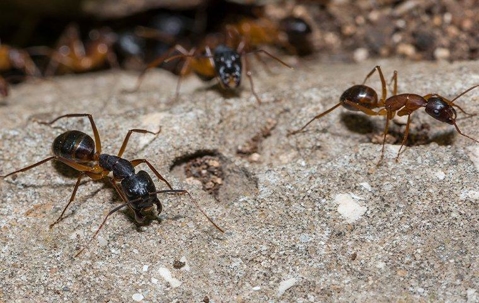For those whose Forth Worth residences are suffering the wrath of wood-destroying pests, a few questions might arise. Why me? Why now? How have thousands of tiny black carpenter ants managed to build their colony inside the floors or walls of my home? To answer these queries, we must explore the factors that likely brought carpenter ants to your property in the first place.
The Most Common Attractants For Invading Carpenter Ants
When it comes to attractants of the carpenter ant, most think they already have it figured out. After all, they are wood-destroying pests. Sure, dry wood is essential for a colony of worker ants to tunnel through, but did you know there are a plethora of other factors at play for them? Allow Lonestar Safe Pest to lay out the common attractants you may otherwise miss:
- Without a doubt, the carpenter ant’s favorite meal derives from a very small pest known as the aphid. This sap-sucking insect, when killed, will secrete a very sweet fluid called honeydew. If aphids end up in your yard, carpenter ants are sure to follow.
- Unfortunately, pest-related attractants do not end with the aphid. Small, dead insects like flies present in your Fort Worth property are also likely to draw the attention of hungry carpenter ants. These easy meals provide quick sustenance for their colonies, after all!
- Contrary to common belief, carpenter ants do not, in fact, eat wood. They chew through it and build their nests in it, but they do not actually consume it. Like most ants, they are omnivores, able and ready to eat a wide variety of foods, from naturally sweet treats like fruits to protein-rich meats.
- Surely, the carpenter ant is no picky pest, as far as human foods go, but if you own a pet, such as a cat or a dog, don’t be quick to assume they are safe either. Bags of dry dog or cat food are yet another frequent source of nutrients for hardworking carpenter ants.
The Disastrous Consequences Of Carpenter Ant Colonies
One of the many dangers inherent to a carpenter ant infestation lies in the oftentimes misplaced focus of the homeowners whose property is infested. When they realize the obvious danger carpenter ants pose to the structural integrity of their homes, it can become easy to miss the intruders who sneak into their kitchens for a snack or take advantage of pest populations of different species to fill the lines of their stomachs.
This is not to underplay the direct danger carpenter ants pose to your property, but rather, to provide examples of the additional side effects of an infestation. The most disastrous consequences of carpenter ant colonies no doubt derive from the placement of their nests in the first place. Unlike similar wood-destroying pests like termites, carpenter ants dig nests not into the ground or above level piles, but the very same wooden pillars they infamously burrow through. When it comes to the carpenter ant, you don’t just need to worry about extended damage from workers’ tunnels, but the heart of their notoriously extensive colonies.
For those who don’t wish to suffer the disastrous consequences of the carpenter ant, there is no better way to combat and control ongoing infestations than by attacking colonies head-on. For a team of professionals you can count on to handle those pests intent on destroying your Fort Worth property, contact Lonestar Safe Pest today.

